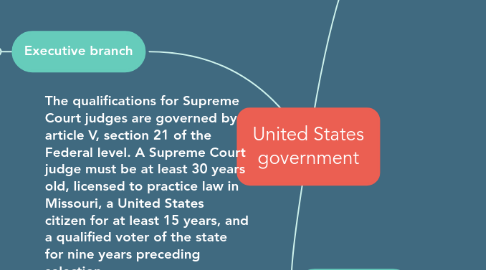United States government
by Chelsie Moore

1. Judicial branch
1.1. The qualifications for Supreme Court judges are governed by article V, section 21 of the Federal level. A Supreme Court judge must be at least 30 years old, licensed to practice law in Missouri, a United States citizen for at least 15 years, and a qualified voter of the state for nine years preceding selection.
1.2. There have been as few as six.
1.3. Nine justices
1.4. The chief justice of the United States is the chief judge of the Supreme Court of the United States and the highest-ranking officer of the U.S. federal judiciary.
1.5. They are appointed for life
1.6. Judicial review
2. Legislative branch
2.1. The House of Representatives and the senate
2.2. Must be at least 25, citizens for seven years, and residents of the states
2.3. 100 Senators and 435 Representatives
2.4. Makes all laws, declares war, regulates interstate and foreign commerce and controls taxing and spend policies.
2.5. One-third of the Senate is up for reelection every two years and there is no term for the House of Representatives.
2.6. Implied powers come from the Constitution's Elastic Clause, which grants Congress power to pass any laws considered necessary and proper for effectively exercising its enumerated powers.
3. Executive branch
3.1. To serve as vice president, an individual must be a natural-born U.S. citizen; be at least 35 years old and be a resident in the U.S. for at least 14 years.
3.2. The President is limited to two four-year terms, but until the 22nd Amendment to the Constitution, ratified in 1951, a President could serve an unlimited number of terms.
3.3. The power to enforce laws.
3.4. The President is responsible for implementing and enforcing the laws written by Congress and, to that end, appoints the heads of the federal agencies, including the Cabinet.
3.5. 15 executive departments, the Secretaries of Agriculture, Commerce, Defense, Education, Energy, Health and Human Services, Homeland Security, Housing and Urban Development, Interior, Labor, State, Transportation, Treasury, and Veterans Affairs, as well as the Attorney General.


